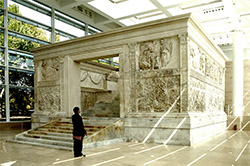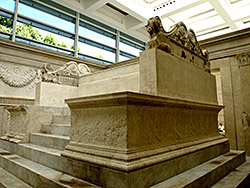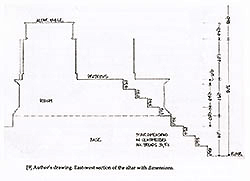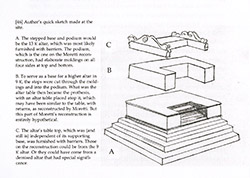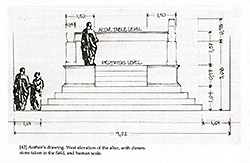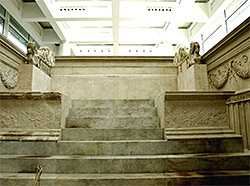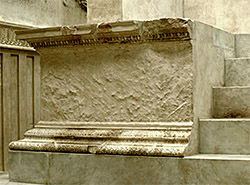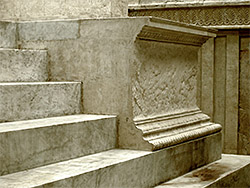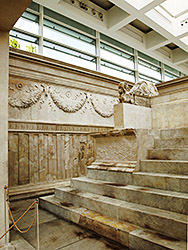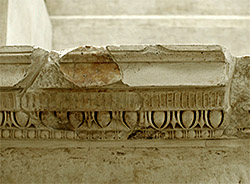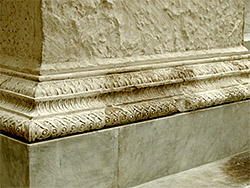Sacrificial Altar
Front - original west face
Reconstruction: The sacrificial altar is the center-piece of the entire Ara Pacis Augustae, yet much of its form and size is necessarily speculative. Very few original parts had survived so that when the archaeologists reconstructed it in 1938 much of its size and shape had to be imagined. The archaeologists have tried to make this clear by distinguishing between original marble and other parts, but this is not normally understood by the public.
Parts of the sacrificial altar: Descriptions in publications are sometimes confusing because some sections of the sacrificial altar are referred to with different terms and the same term is sometimes used to refer to different sections.
The use of the term “altar” alone can be especially confusing. In publications one finds this term occasionally used to refer to the Ara Pacis as a whole, often to the entire structure within the enclosing precinct walls, sometimes to the portion of the sacrifical altar above the base, or above the plinth, or, at the extreme, to the sacrificial table only.
On this website, the parts of the structure within the precinct walls are distinguished as follows.
Sacrificial altar – the entire structure within the enclosing precinct walls.
Base – the 3 lowest levels. In the front these serve as stairs.
Plinth – the level above the base and below the podium. In the front, the plinth serves as the first step up to the sacrificial table.
Podium – the large u-shaped structure resting on the plinth and below the hypothetical structure sometimes called the "prothesis". 4 steps are set into the front of the podium, leading to it's top, the level on which priests would stand.
Prothesis - the large u-shaped structure (hypothetically reconstructed in 1938 with no original parts) resting on the podium and supporting the sacrificial table in the center and 2 crowning elements along the sides.
Sacrificial table (mensa) – the flat, horiizontal slab on top of the prothesis, between the back halves of the 2 side crowning elements. Scholars agree that there were originally figural friezes front and back.
Crowns – the 2 elaborate vertical side elements, resting on the sides of the prothesis.
Each of these 2 vertical elements consists of:
Friezes and griffin-lions - the bottom level of the vertical side crowns.
Volutes – the top level of the vertical side crowns.
TO ZOOM IN ON THE LARGE IMAGES, USE THE BUTTONS AT TOP-LEFT.
Tips for using this website
